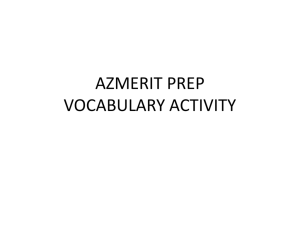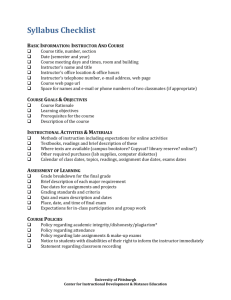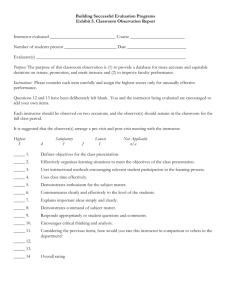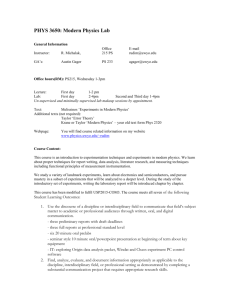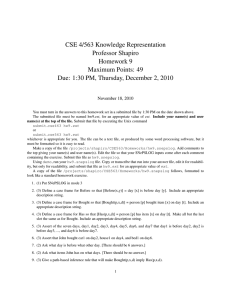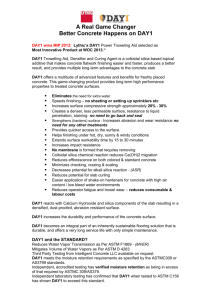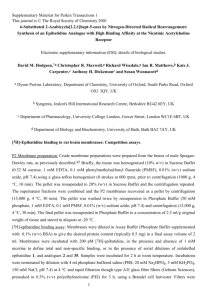ECNT 1103 - Oklahoma State University Institute of Technology
advertisement
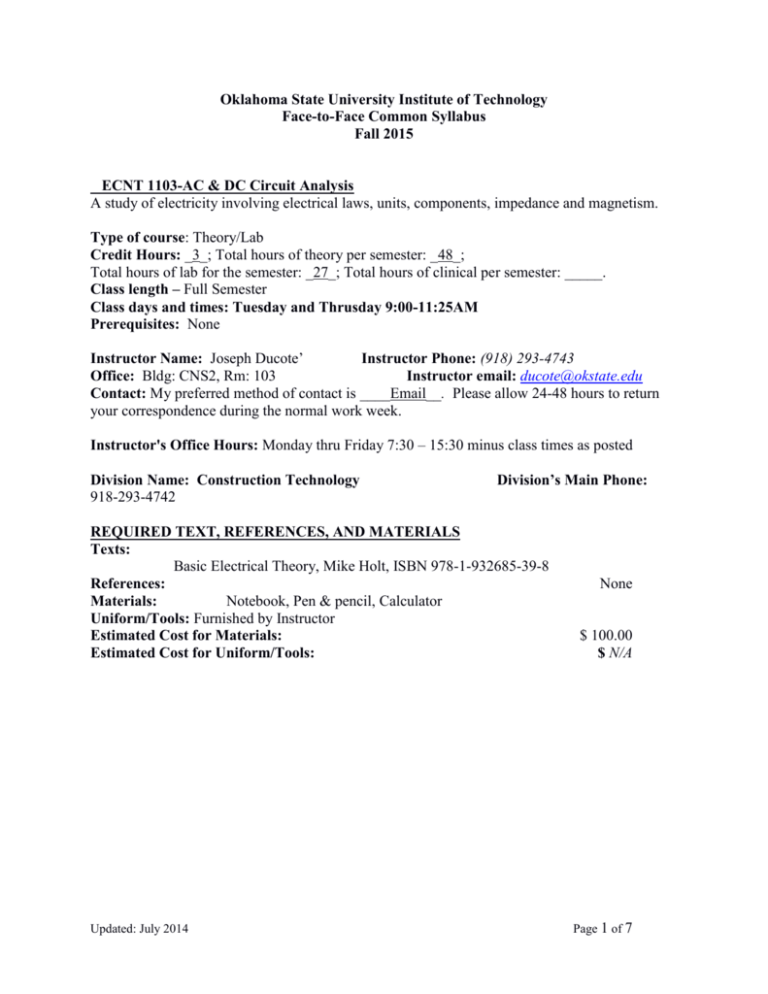
Oklahoma State University Institute of Technology Face-to-Face Common Syllabus Fall 2015 ECNT 1103-AC & DC Circuit Analysis A study of electricity involving electrical laws, units, components, impedance and magnetism. Type of course: Theory/Lab Credit Hours: _3_; Total hours of theory per semester: _48_; Total hours of lab for the semester: _27_; Total hours of clinical per semester: _____. Class length – Full Semester Class days and times: Tuesday and Thrusday 9:00-11:25AM Prerequisites: None Instructor Name: Joseph Ducote’ Instructor Phone: (918) 293-4743 Office: Bldg: CNS2, Rm: 103 Instructor email: ducote@okstate.edu Contact: My preferred method of contact is ____Email__. Please allow 24-48 hours to return your correspondence during the normal work week. Instructor's Office Hours: Monday thru Friday 7:30 – 15:30 minus class times as posted Division Name: Construction Technology 918-293-4742 Division’s Main Phone: REQUIRED TEXT, REFERENCES, AND MATERIALS Texts: Basic Electrical Theory, Mike Holt, ISBN 978-1-932685-39-8 References: Materials: Notebook, Pen & pencil, Calculator Uniform/Tools: Furnished by Instructor Estimated Cost for Materials: Estimated Cost for Uniform/Tools: Updated: July 2014 None $ 100.00 $ N/A Page 1 of 7 Upon completion of the course, students should: Course Objectives Assessment of Objectives 1103-1. (DC & AC Analysis) Correctly Answer Questions concerning Electrical Theory Fundamentals and Electrical Properties Answer questions about the atomic structure of an atom and how it affects electrical properties 1103-2. (DC & AC Analysis) Utilize Ohms Law as it relates to electrical properties by finding solutions to given scenarios Answer questions about the relationship between the various electrical properties 1103-3. (DC & AC Analysis) Perform calculations of different electrical configurations and show how they affect the electrical properties in the circuit Calculate for unknown electrical property values in series, parallel, and complex circuits 1103-4. (DC & AC Analysis) Determine proper Electrical System Protection device uses, selection, and operation Answer question about the placement, selection, and operation of electrical protective devices 1103-5. (DC & AC Analysis) Understand and Use AC single phase and an AC 3 phase electrical system and properties affecting an AC circuit Calculate the unknown values in given circuits that include inductive loads, capacitive loads, and power factors 1103-6. (DC & AC Analysis) Describe how electrical energy is generated, transformed, and converted to mechanical energy Answer questions and provide illustration describing induction, generators, motors and transformers Aspects of the course objective assessments may be used in the university’s assessment of student learning. If applicable, an asterisk (*) above indicates this course is used in the university assessment program. COURSE ACTIVITIES In this course students will: Participate in discussions of readings of assigned text View videos that depict the various concepts discussed in class and assignments Participate in in-class activities and lab exercises Take examinations Updated: July 2014 Page 2 of 7 EVALUATION - GRADES WILL BE BASED ON THE QUALITY AND COMPLETION OF THESE TASKS: (NOTE-Please indicate the course specific evaluations.) Class Participation ..... 20% Projects/Homework…..0% Unit Quiz .................... 30% Chapter/Final Exam ….50% Total………………_100%__ OSUIT Grading Scale A = 90%-100% B = 80%-89% C = 70%-79% D = 60%-69% F = 59% & below *The student’s grade for this assignment will be used in the university’s assessment of student learning. A 70% competency or higher receives a Pass rating. This Pass/Fail rating is independent of the student’s course grade. Daily and/or weekly quizzes, small weekly assignments and similar type projects: Normal return time to student by next class meeting or no later than one (1) week. Extensive assignments, large lab projects, extensive quizzes, exams and similar type projects: Normal return time to students in one (1) to two (2) weeks. AUTHORIZED TOOLS Electrical tools required for this course during lab activities will be furnished by the instructor. Students may use any/all course materials, including books and notes, while participating in classroom activities. LATE WORK As a general rule late work will not be accepted. Exceptions may be made on an individual basis only if prior arrangements have been made with the instructor. TESTING Students are expected to cooperate in maintaining a classroom environment conducive to learning. Courteous and respectful behavior will be expected from all students each day. All pagers, cellular phones, CD and MP3 players must be turned off. During testing no electronic devices may be utilized other than non-programmable calculators. No Jewelry will be worn in any electrical class due to electrical shock hazards. When working on a lab exercise, all required personal protective equipment must be available and correctly worn. UNIVERSITY & COURSE EXPECTATIONS It is the responsibility of each OSUIT student to read, abide by and maintain a copy of the syllabus for this course. Syllabi are available on the OSUIT website. Students understand that excerpts or portions of their work may be utilized for institutional assessment purposes. The purpose of institutional assessment is for verification of student Updated: July 2014 Page 3 of 7 learning and program improvement. Every effort will be made to keep this information confidential. AMERICANS WITH DISABILITIES ACT (ADA) According to the Americans with Disabilities Act, each student with a disability is responsible for notifying the University of his/her disability and requesting accommodations. If you think you have a qualified disability and need special accommodations, you should notify the instructor and request verification of eligibility for accommodations from the Office of Academic Accommodations/LASSO Center. Please advise the instructor of your disability as soon as possible, and contact The LASSO Center, located in the Noble Center for Advancing Technology – NCAT, top floor, and 918-293-4855 to ensure timely implementation of appropriate accommodations. Faculty have an obligation to respond when they receive official notice of a disability but are under no obligation to provide retroactive accommodations. To receive services, you must submit appropriate documentation and complete an intake process during which the existence of a qualified disability is verified and reasonable accommodations are identified. (Fall 2013) ACADEMIC DISHONESTY Academic dishonesty or misconduct is neither condoned nor tolerated at OSUIT. Any student found guilty of academic dishonesty or misconduct shall be subject to disciplinary action. Academic dishonesty and/or misconduct includes, but is not limited to, the following actions: (1) Plagiarism: the representation of previously written, published, or creative work as one’s own; (2) Unauthorized collaboration on projects; (3) Cheating on examinations; (4) Unauthorized advance access to exams; (5) Fraudulent alteration of academic materials; (6) Knowing cooperation with another person in an academically dishonest undertaking. Students are required to actively protect their work against misuse by others. For details, refer to The OSUIT Student Handbook (Student Rights and Responsibilities Governing Student Behavior) available online at http://www.osuit.edu/academics/forms/student_rights_responsibility.pdf. ATTENDANCE POLICY FOR FACE-TO-FACE COURSES A primary component of OSUIT's Mission is “to prepare and sustain a diverse student body as competitive members of a world-class workforce.” Regular and consistent attendance not only aids in academic success, dependable attendance is a requirement in today's real-world employment; therefore, regular and consistent attendance is a requirement in all OSUIT courses. Definitions: Absent: Failing to attend all or a significant portion of a class or lab session. A. Students may not be marked as absent if missing class for situations such as, but not limited to 1. participating in a required university activity such as a field trip; 2. fulfilling a military obligation; 3. a mandatory court appearance; 4. death in the immediate family; 5. extreme illness or accident to oneself or immediate family. Instructors, at their discretion, may require proof of such events. B. It is the responsibility of the student to contact and inform the instructor and/or department in advance of such excused absences whenever possible. Tardy: Arriving late to class as defined by the individual class instructor. Faculty, at their discretion, may equate three tardies to equal one absence. Updated: July 2014 Page 4 of 7 Procedures: Early Intervention A. Any student who misses 10% of an individual course (or earlier at faculty discretion) during a regular fifteen-week semester, or the equivalent portion of time in a shorter session, will have their name submitted by that course instructor to the OSUIT Early Alert System for retention intervention. B. At the point the Early Alert is issued, the student must meet with their assigned faculty advisor or designated faculty/staff member within seven (7) academic calendar days for counseling on how to improve their attendance and academic success. Excessive Absences A. The University reserves the right to administratively withdraw any student from an individual course who misses 20% of that course, whether excused or unexcused, and, in the opinion of the instructor, the student does not have a reasonable opportunity to be successful in the course. B. Students should be aware any of the following may impact their financial aid: 1. being administratively withdrawn from a course 2. dropping a course 3. their last date of attendance in a course Please see OSUIT Policy 2-021 for full details and procedures. Course Schedule Course Outline Schedule Day 1/Week 1 Day 1/Week 2 Day 2/Week 2 Day1/Week 3 Day2/Week 3 Day1/Week 4 Day2/Week 4 Day1/Week 5 Updated: July 2014 Topic Introductions, Review Syllabus, Course Expectations Chapter 1, Units 1, 2, & 3 Chapter 1, Units 4, 5, & 6 Review for Chapter 1 Test Test Chapter 1 Begin discussion Chapter 2 Chapter 2, Units 7, 8, & 9 Review for Chapter 2 Test Test Chapter 2, Begin discussion Chapter 3 Chapter 3 Unit 10, Series circuits Review Series Circuit Worksheets Assignment Due Date Read Chapter 1, Units 1, 2, 3 and complete practice questions Next Class Read Chapter 1, Units 4, 5, 6 and Next Class complete practice questions Review for Chapter 1 Test Next Class Read Chapter 2, Units 7, 8, & 9 and complete practice questions Review for Chapter 2 Test Next Class Next Class Read Chapter 3 Unit 10 and Next Class complete practice questions Complete worksheets given out Next Class by instructor Read Chapter 3 Unit 11 and Next Class complete practice questions Page 5 of 7 Day2/Week 5 Day1/Week 6 Day2/Week 6 Day1/Week 7 Day2/Week 7 Day1/Week 8 Day2/Week 8 Day1/Week 9 Day2/Week 9 Day1/Week 10 Day2/Week 10 Day1/Week 11 Day2/Week 11 Day1/Week 12 Day2/Week 12 Day1/Week 13 Day2/Week 13 Day1/Week 14 Chapter 3 Unit 11, Parallel Circuits Review Parallel Circuit Worksheets Chapter 3 Unit 12, SeriesParallel Circuits Chapter 3 Unit 13, Review for Chapter 3 Test Test Chapter 3, Begin discussion Chapter 4 Chapter 4 Unit 14 Complete worksheets given out by instructor Read Chapter 3 Unit 12 and complete practice questions Complete worksheets given out by instructor, Read Unit 13 Review for Chapter 3 Test Read Chapter 4 Unit 14 and complete practice questions Read Chapter 6 Unit 22 and complete review questions Chapter 6 Unit 22 Read Chapter 4 Unit 15 and complete review questions Chapter 4 Unit 15 and Review for Test Chapter 4 Unit review for test 14 & 15, Chapter 6 Unit 22 Test Chapter 4 & Chapter 6 Read Chapter 5 Units 16 & 17 Unit 22, Begin Chapter 5 and complete review questions Chapter 5 Units 16 & 17 Read Chapter 5 Units 18 & 19 and complete review questions Chapter 5 Units 18 & 19 Review for test Chapter 5 Units and review for test 16, 17, 18, & 19 Test Chapter 5 Read Chapter 6 Units 20 & 21 and complete Review questions Chapter 6 Units 20 & 21 Review Chapter 6 Units 20 & 21 Review Chapter 6 Units 20 & 21 Test Chapter 6 Review Annex A Grounding and Bonding No Class Next Class Next Class Next Class Next Class Next Class Next Class Next Class Next Class Next Class Next Class Next Class Next Class Next Class Review Chapter 6 Units 20 & 21 Next Class Read Annex A Grounding and Next Class Bonding Review Annex A Grounding and Next Class Bonding No Class N/A Review for Final Exam Next Class Day2/Week 14 Test Annex A Grounding and Bonding Review for Final Exam Review for Final Exam Next Class Day1/Week 15 Review for Final Exam Review for Final Exam Next Class Day2/Week 15 Final Exam N/A N/A Updated: July 2014 Page 6 of 7 (Schedule is subject to change at instructor discretion.) Updated: July 2014 Page 7 of 7
